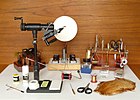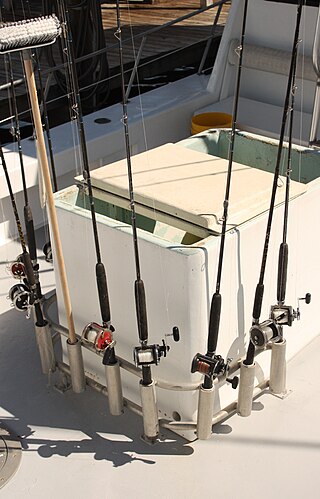
A fishing rod is a long, thin rod used by anglers to catch fish by manipulating a line ending in a hook. At its most basic form, a fishing rod is a straight rigid stick/pole with a line fastened to one end ; however, modern rods are usually more elastic and generally have the line stored in a reel mounted at the rod handle, which is hand-cranked and controls the line retrieval, as well as numerous line-restricting rings that distribute bending stress along the rod and help dampening down/prevent line whipping and entanglement. To better entice fish, baits or lures are dressed onto the hook attached to the line, and a bite indicator is typically used, some of which might be incorporated as part of the rod itself.
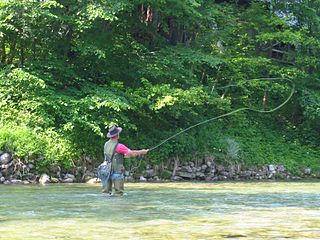
Fly fishing is an angling technique that uses an ultra-lightweight lure called an artificial fly, which typically mimics small invertebrates such as flying and aquatic insects to attract and catch fish. Because the mass of the fly lure is insufficient to overcome air resistance, it cannot be launched far using conventional gears and techniques, so specialized tackles are used instead and the casting techniques are significantly different from other forms of angling. It is also very common for the angler to wear waders, carry a hand net, and stand in the water when fishing.

Jigging is the practice of fishing with a jig, a type of weighted fishing lure. A jig consists of a heavy metal sinker with an attached fish hook that is usually obscured inside a soft lure or feather-like decorations. Jigs are intended to create a jerky, vertical "jumping" motion to attract fish, as opposed to other common lures like swimbaits, spoons and spinnerbaits, which move through the water more or less horizontally. The jig is very versatile and can be used in both salt and fresh water. Many deeper water fish species are attracted to the lure, which has made it popular among anglers for years.

A fishing lure is any one of a broad category of artificial angling baits that are inedible replicas designed to mimic prey animals that attract the attention of predatory fish, typically via appearances, flashy colors, bright reflections, movements, vibrations and/or loud noises which appeal to the fish's predation instinct and entice it into gulping the lure. Angling activities using lures are known as lure fishing.

Fly tying is the process of producing an artificial fly used by fly fishing anglers to catch fish. Fly tying is a manual process done by a single individual using hand tools and a variety of natural and manmade materials that are attached to a hook. Although the recent history of fly tying dates from the middle 1800s, fly tyers were engaged in tying flies since at least 200 AD.

The Woolly Bugger is an artificial fly commonly categorized as a wet fly or streamer and is fished under the water surface. It is a popular and widely used pattern for both freshwater and saltwater game fish and is generally listed as one of the top patterns to have in any fly box. John Gierach, a noted fly fishing writer discussed the Woolly Bugger first in his chapter on streamers in Good Flies. Woolly Buggers are typically fished in streams, rivers, ponds, lakes, and tidal flats. Today, Woolly Buggers are tied in a wide variety of styles and colors to imitate a wide range of game fish prey.
The Woolly Bugger is so effective, it should be banned from some watersheds. I suspect its effectiveness is due to its resemblance to so many edible creatures in the water—nymphs, leeches, salamanders, or even small sculpins. Its tail undulating behind a fiber, bubble-filled body is just too much for most fish to resist. It just looks like a meal!

The Pheasant Tail nymph or PT Nymph or Sawyer's Pheasant Tail is a popular all purpose nymph imitation used by fly anglers. It imitates a large variety of olive, olive-brown colored aquatic insect larvae that many fish including trout and grayling feed upon.

An artificial fly or fly lure is a type of fishing lure, usually used in the sport of fly fishing. In general, artificial flies are an imitation of aquatic insects that are natural food of the target fish species the fly fishers try to catch. Artificial flies are constructed by fly tying, in which furs, feathers, thread or any of very many other materials are tied onto a fish hook.
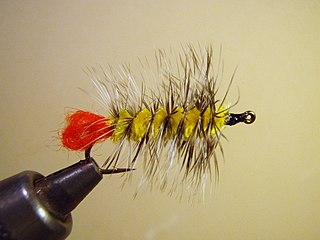
The Woolly Worm is an artificial fly commonly categorized as a wet fly or nymph and is fished under the water surface. It is a popular pattern for freshwater game fish and was a very popular fly in the 1950s–1970s in the west. Charles Brooks in Nymph Fishing for Larger Trout recommends the Woolly Worm as a general purpose nymph pattern in most western trout waters in any fly box. Woolly Worms are typically fished in streams, rivers, ponds, and lakes for trout, bass, and panfish. Today, Woolly Worms are tied in a variety of styles and colors to imitate a large aquatic nymphs such as stoneflies, dragonflies, damselflies or hellgrammites.
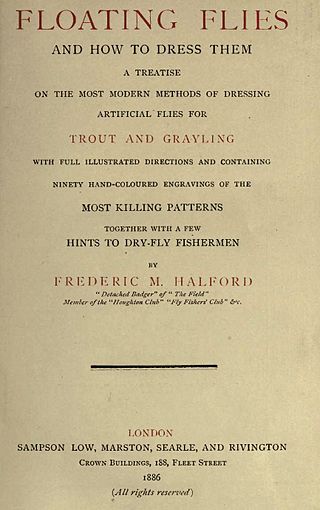
Floating Flies and How to Dress Them - A Treatise on the Most Modern Methods of Dressing Artificial Flies for Trout and Grayling with Full Illustrated Directions and Containing Ninety Hand-Coloured Engravings of the Most Killing Patterns Together with a Few Hints to Dry-Fly Fishermen is a fly fishing book written by Frederic M. Halford published in London in April 1886 by Sampson Low. A deluxe edition on large paper sold out before publication and the trade edition of 500 nearly so.
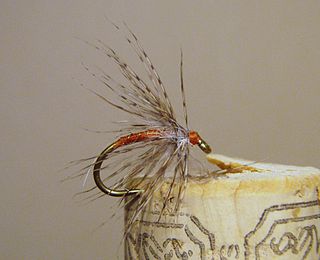
The Partridge and Orange is an artificial fly commonly categorized as a wet fly or soft hackle and is fished under the water surface. The fly is a very well known fly with its roots set firmly in English angling history. It is an impressionistic pattern fished successfully during caddis hatches and spinner falls. The Partridge and Orange is traditionally a trout and grayling pattern but may be used for other aquatic insect feeding species.

The Royal Coachman is an artificial fly that has been tied as a wet fly, dry fly and streamer pattern. Today, the Royal Coachman and its variations are tied mostly as dry flies and fished floating on the water surface. It is a popular and widely used pattern for freshwater game fish, particularly trout and grayling. Large streamer versions are also used for winter steelhead and Atlantic salmon.

Tenkara fishing is a type of simple rod angling traditionally practiced in Japan. Primarily used for mountain stream trout fishing, tenkara is still a fairly rare method even among freshwater anglers in Japan, and was largely unknown outside Japan until 2009, when the company Tenkara USA, founded by Daniel Galhardo, introduced and popularized tenkara outside Japan.
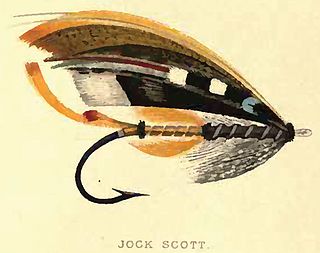
Fully dressed flies are elaborate and colorful artificial flies used in fly fishing. The most famous of these are the classic salmon flies, which are exquisite patterns made from mostly rare and beautiful materials and feathers, including golden pheasants, toucans, swans, and ivory-billed woodpeckers. These flies have been popular in the United Kingdom since the 19th century. Fully dressed flies are often meant for display and are not used in actual fishing. Many patterns are expensive to tie because of the cost of rare feathers.

This annotated bibliography is intended to list both notable and not so notable works of English language, non-fiction and fiction related to the sport of fly fishing listed by year published. Although 100% of any book listed is not necessarily devoted to fly fishing, all these titles have significant fly fishing content. Included in this bibliography is a list of fly tying, fly tackle, regional guides, memoirs, stories and fly fishing fiction related literature.
Carrie Gertrude Stevens (1882–1970) was an American fly fisher and fly lure tier from Madison and Upper Dam, Maine, and the creator of Rangeley Favorite trout and salmon flies. Self-taught in the art of fly tying, Stevens invented the Grey Ghost Streamer, an imitation of the Smelt, Osmerus mordax. Stevens' flies received national and international acclaim, and she was honored after her death with the naming of August 15, 1970 as "Carrie Gertrude Stevens Day" by the Governor of Maine.
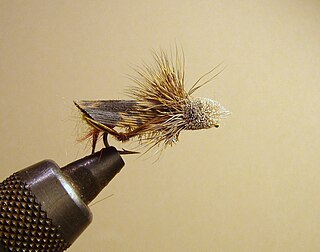
Dave's Hopper is an artificial fly used for fly fishing, designed to imitate adult grasshoppers and other Orthoptera species. It is considered a dry fly terrestrial pattern. It was designed by fly tyer and angler Dave Whitlock, and combines the best aspects of Joe's Hopper and Muddler Minnow patterns.

Parks' Salmonfly is a traditional dry fly imitating adults of the family of giant stoneflies or salmonflies (Pteronarcyidae). The most commonly imitated species is Pteronarcys californica or salmonfly common throughout Western North America from British Columbia to California.
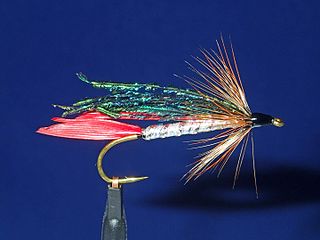
The Alexandra wet fly is an artificial fly. Also known as the Lady of the Lake, the fly was named by English angler Major William Greer Turle to honour Alexandra, Princess of Wales. The fly is distinguished by the heavy peacock herl wing and silver body which makes the fly resemble a small baitfish or fry. The Alexandra proved to be a very effective fly for trout in lakes and streams in England and Scotland in the late 19th and early 20th century. Many fly fishing purists derided the fly and its use was once banned on many English waters.

The Sakasa Kebari or reverse-hackle fly, is an artificial fly most associated with the Japanese style of tenkara fishing but can be used in most freshwater fly fishing. The Sakasa Kebari is usually defined by firstly, its reverse hackle and secondly, by its simplicity as compared to western style flies. This fly was originally created to be used in the small, high gradient streams in Japan while fishing for native trout and char.






















